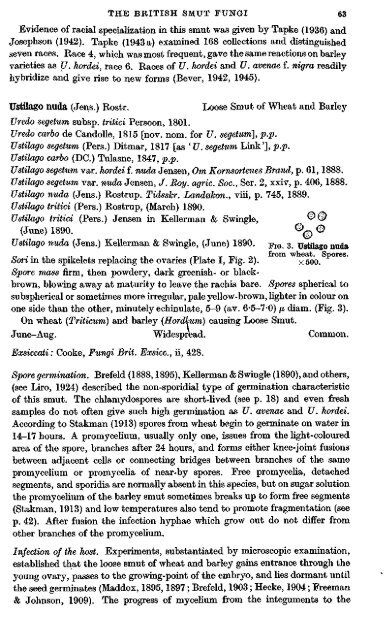nmm sP
nmm sP
nmm sP
You also want an ePaper? Increase the reach of your titles
YUMPU automatically turns print PDFs into web optimized ePapers that Google loves.
THE BRITISH SMUT FUNGI 63<br />
Evidence of racial speciaKzation in this smut was given by Tapke (1936) and<br />
Josephson (1942). Tapke (1943 a) examined 168 collections and distinguished<br />
seven races. Race 4, which was most frequent, gave the same reactions on barleyvarieties<br />
as U. hordei, race 6. Races of U. hordei and U. avenae f. nigra readily<br />
hybridize and give rise to new forms (Bever, 1942, 1945).<br />
Ustilago nuda (Jens.) Rostr. Loose Smut of Wheat and Barley<br />
Vredo segetum subsp. tritici Persoon, 1801.<br />
Uredo carbo de CandoUe, 1815 [nov. nom. for U. segetum], p.p.<br />
Ustilago segetum (Pers.) Ditmar, 1817 [as ' U. segetum Link'], p.p.<br />
Ustilago carbo (DC.) Tulasne, 1847, p.p.<br />
Ustilago segetum var. hordei f. nuda Jensen, Om Kornsortenes Brand, p. 61,1888.<br />
Ustilago segetum var. nuda Jensen, J. Roy. agric. Soc, Ser. 2, xxiv, p. 406,1888.<br />
Ustilago nuda (Jens.) Rostrup. Tidsskr. Landakon., viii, p. 745, 1889.<br />
Ustilago tritici (Pers.) Rostrup, (March) 1890.<br />
Ustilago tritici (Pers.) Jensen in Kellerman & Swingle, ©©<br />
(June) 1890. ^^ ©<br />
Ustilago nuda (Jens.) Kellerman & Swingle, (June) 1890. y^Q 3 xjstilago nuda<br />
„ . . ,1 ., , , . , . ,T^, T -r-.. £M from wheat. Spores.<br />
8ori m the spikelets replacmg the ovaries (Plate I, lig. 2). x500.<br />
Spore mass firm, then powdery, dark greenish- or blackbrown,<br />
blowing away at maturity to leave the rachis bare. Spores spherical to<br />
subspherical or sometimes more irregular, pale yeUow-brown, lighter in colour on<br />
one side than the other, minutely echinulate, 5-9 (av. 6-5-7-0) fi diam. (Fig. 3).<br />
On wheat (Triticum) and barley (Hordium) causing Loose Smut.<br />
June-Aug. Widespread. Common.<br />
Exsiccati: Cooke, Fungi Brit. Exsicc., ii, 428.<br />
Spore germination. Brefeld (1888,1895), Kellerman & Swingle (1890), and others,<br />
(see Liro, 1924) described the non-sporidial type of germination characteristic<br />
of this smut. The chlamydospores are short-lived (see p. 18) and even fresh<br />
samples do not often give such high germination as U. avenae and U. hordei.<br />
According to Stakman (1913) spores from wheat begin to germinate on water in<br />
14-17 hours. A promycelium, usually only one, issues from the Hght-coloured<br />
area of the spore, branches after 24 hours, and forms either knee-joint fusions'<br />
between adjacent cells or connecting bridges between branches of the same<br />
promycelium or promycelia of near-by spores. Free promyceHa, detached<br />
segments, and sporidia are normally absent in this species, but on sugar solution<br />
the promycelium of the barley smut sometimes breaks up to form free segments<br />
(Stakman, 1913) and low temperatures also tend to promote fragmentation (see<br />
p. 42). After fusion the infection hyphae which grow out do not differ from<br />
other branches of the promycehum.<br />
Infection of the host. Experiments, substantiated by microscopic examination,<br />
established that the loose smut of wheat and barley gains entrance through the<br />
young ovary, passes to the growing-point of the embryo, and lies dormant until<br />
the seed germinates (Maddox, 1895,1897 ; Brefeld, 1903; Hecke, 1904; Freeman<br />
& Johnson, 1909). The progress of mycehum from the integuments to the

















